Monstera deliciosa, often referred to as the “Swiss cheese plant”, is a staple in homes worldwide, renowned for its striking perforated leaves and tropical allure. The Monstera, native to Central America, has been cultivated for decorative and symbolic purposes for centuries, its presence ranging from ancient Aztec rituals to modern urban apartments.
But why does Monstera drip water? Is it weeping or sweating? The answer is simple; Guttation, a phenomenon witnessed in a variety of plants, including Monstera, is the process of exuding water droplets from the leaf’s tips or edges. Root pressure, influenced by factors like soil moisture and environmental conditions, drives this intriguing occurrence.
Beyond just the spectacle of water droplets on your beloved plant, this article unravels the mechanics of guttation in Monsteras. With insights into its leaf anatomy, root pressures, environmental factors, and health implications, you’ll gain a comprehensive understanding of this captivating botanical mystery, empowering you to offer optimal care to your verdant companion.
Monstera and Guttation: An Unexpected Water Show
Guttation stands as one of the unique marvels of plant physiology. Contrary to the common misconception of these droplets being “plant sweat” or “dew,” guttation is a much more intricate process rooted deep in biology.
Understanding Guttation: The Science Behind the Drops
Guttation refers to the exudation of droplets of water from the edges or tips of leaves of certain plants, especially during the nighttime. The process is facilitated by specific structures known as hydathodes.
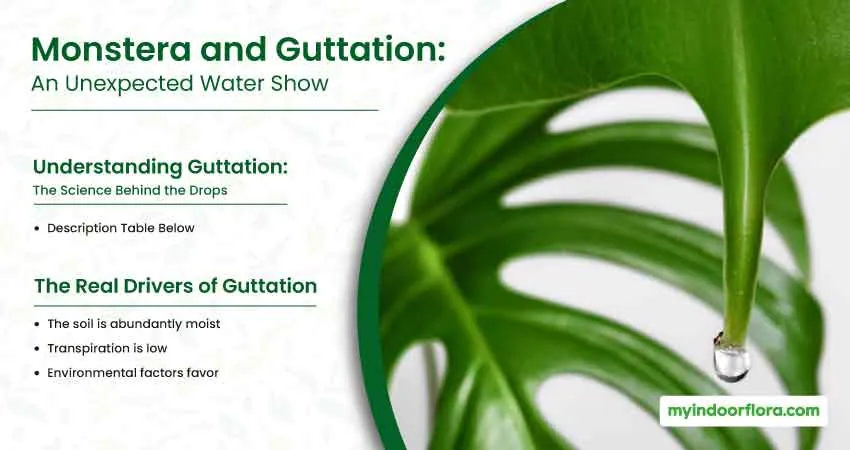
| Parameter | Guttation | Dew |
|---|---|---|
| Origin | Internal (within the plant) | External (atmospheric moisture) |
| Process | Exudation due to root pressure | Condensation of atmospheric moisture |
| Location on leaf | Typically at the leaf tips or edges | Evenly distributed over the leaf surface |
| Composition | Mostly water with some dissolved minerals and nutrients | Pure water |
In a study published in the Journal of Botanical Sciences, researchers emphasized the function of guttation in maintaining a balance in the plant’s internal water pressure, especially in tropical plants like Monstera deliciosa.
The Real Drivers of Guttation
Guttation predominantly occurs when:
- The soil is abundantly moist – Excess water means higher uptake by the plant roots.
- Transpiration is low – Transpiration, a daytime process, sees plants releasing water vapor. Its reduction at night ensures less water loss, thereby accumulating excess moisture.
- Environmental factors favor – High humidity and cooler nights are often key catalysts for guttation.
Experts from the International Journal of Plant Sciences in 2014 mentioned that guttation might also be an adaptive mechanism for some plants, assisting in eliminating excess water to prevent root damage.
Monstera’s Root Pressure: The Force Behind the Drips
Root pressure remains a central player in the guttation phenomenon. It might seem strange to think of plants having “pressure,” but this natural force is fundamental to their water transport system.
Demystifying Root Pressure
Root pressure is the positive pressure that develops in the roots of plants by the active absorption of nutrients and water. It pushes the water upwards through the plant, sometimes with enough force to exude it through the hydathodes.
| Factor | Impact on Root Pressure |
|---|---|
| Soil moisture | Higher soil moisture increases root pressure. |
| Time of day | Typically builds up during the night due to reduced transpiration. |
| Mineral nutrient absorption | Active absorption can enhance osmotic pressure, amplifying root pressure. |
| Plant health | Healthy plants often exhibit consistent root pressures. |
In a comprehensive paper from Plant Physiology and Biochemistry in 2015, researchers likened root pressure to a mini hydraulic system. When external conditions suppress the upward movement of water through transpiration, this hydraulic push becomes evident in forms like guttation.
The Night Saga: Root Pressure’s Special Relationship with Darkness
With the sun down, the stomata (tiny openings on leaves) tend to close, reducing transpiration drastically. However, root water absorption doesn’t halt. This mismatch leads to the build-up of root pressure. A study in the Journal of Plant Research shed light on this nightly buildup, explaining its significance in nutrient transportation and guttation facilitation.
Experts often argue that this nightly water push, driven by root pressure, aids in the transportation of nutrients in the absence of transpiration, making it an essential mechanism for overall plant health.
Soil Moisture Levels: Overwatering and Its Consequences
The amount of water present in the soil greatly affects the well-being of a plant. This isn’t simply about providing water, but understanding the balance required to ensure plants, like the Monstera, thrive.
Understanding Soil Moisture Dynamics
Soil moisture isn’t just about wet or dry; it’s about the retention and movement of water within the soil profile. Various factors, like soil composition, play a significant role in this.
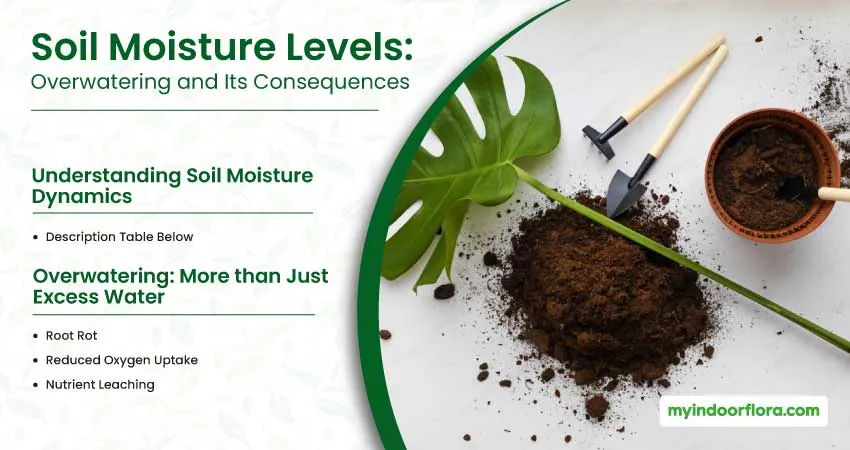
| Soil Type | Water Retention Capacity | Ideal For Monstera? |
|---|---|---|
| Sandy | Low retention, fast drainage | No |
| Loamy | Moderate retention | Yes |
| Clayey | High retention, slow drainage | No |
In a study from the Journal of Soil Science and Plant Nutrition, it was found that plants planted in loamy soil had the best growth rate, showcasing the importance of optimal soil moisture retention.
Overwatering: More than Just Excess Water
Overwatering isn’t merely about the quantity of water but the frequency. The consequences of overwatering are far-reaching.
- Root Rot: Overwatered soil becomes a breeding ground for fungi. One such fungus, Phytophthora, is notorious for causing root rot in plants like Monstera, as indicated by a 2016 article in the Journal of Plant Pathology.
- Reduced Oxygen Uptake: Roots need oxygen to breathe. Overwatered soil can suffocate the plant’s roots, leading to their decay.
- Nutrient Leaching: A study in the Journal of Environmental Management showed that overwatered soil can cause essential nutrients to leach away, depriving plants of their nutritional needs.
Monstera’s Leaf Anatomy: A Close Look at Hydathodes
The Monstera leaf isn’t just about aesthetic beauty. Its anatomy, particularly the presence of hydathodes, plays a pivotal role in its physiological activities.
Hydathodes: Nature’s Minute Outlets
Hydathodes are tiny pores, primarily on the leaf’s edges or tips, responsible for water exudation. Unlike stomata, which manage gas exchange, hydathodes are explicitly geared towards guttation.
| Parameter | Hydathodes | Stomata |
|---|---|---|
| Function | Exude water through guttation | Manage gas exchange, primarily transpiration |
| Location | Leaf edges/tips | Scattered throughout leaf |
| Size | Larger than stomata | Smaller |
| Opening/Closing | Doesn’t actively open or close | Actively opens or closes with light & moisture |
Hydathodes are more prevalent in plants living in high-humidity environments, highlighting their adaptation significance.
The Crucial Role of Hydathodes in Guttation
Hydathodes serve as exit points during guttation. When root pressure builds up, and the plant cannot release excess water through transpiration, hydathodes come into play. According to a research piece in Plant Physiology, hydathodes in Monstera leaves act as safety valves, releasing excess water to prevent internal damage.
Moreover, an interesting observation shared by Dr. Susan M. Banks in a paper for the Botanical Society of America highlighted that while guttation is common in many plants, the Monstera’s large leaf size and unique perforations possibly enhance its ability to exhibit this phenomenon more prominently.
Environmental Factors Affecting Water Dripping in Monstera
The environment surrounding a Monstera plays a pivotal role in determining its water dripping behavior. Here’s an insight into the environmental intricacies involved.
The Humidity Connection
High humidity levels can amplify the guttation process. When the air is saturated with moisture, the plant’s transpiration process slows down, creating an internal water surplus.
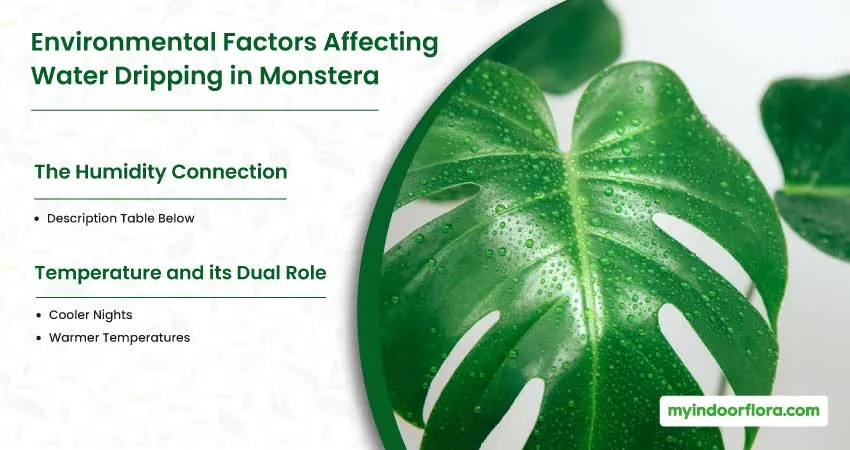
| Humidity Levels | Impact on Monstera Guttation |
|---|---|
| Low (<40%) | Reduces the chances of guttation as plants can transpire freely |
| Moderate (40%-60%) | Occasional guttation; depends on other factors like soil moisture |
| High (>60%) | Increases the likelihood of guttation, especially if combined with other supporting factors |
Plants in tropical climates, like Monstera, are naturally adapted to high humidity environments. Their behavior, including guttation, is intrinsically linked to these conditions.
Temperature and its Dual Role
Temperature doesn’t just affect a plant’s metabolic rate; it also impacts its water relations.
- Cooler Nights: Often boost the guttation process. Cooler temperatures cause a reduction in transpiration, leading to increased root pressure and subsequent guttation.
- Warmer Temperatures: Can either reduce guttation due to increased transpiration or amplify it if paired with high soil moisture and humidity. The exact response depends on the balance of these factors.
Distinguishing Guttation from Other Plant Concerns
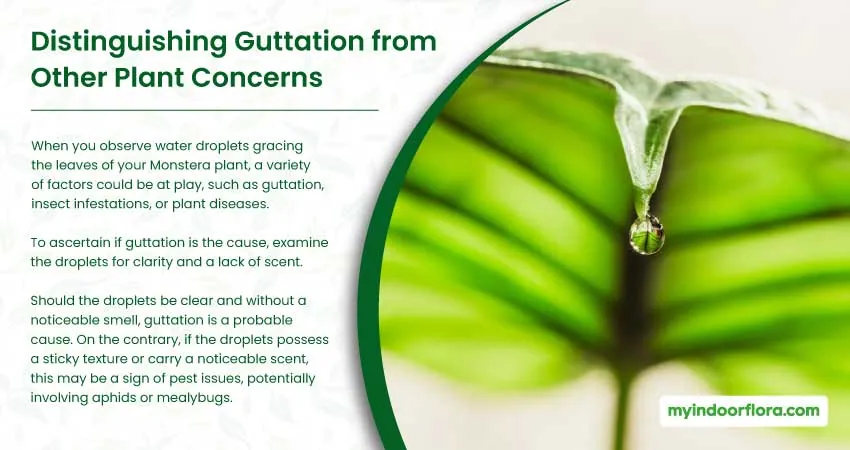
When you observe water droplets gracing the leaves of your Monstera plant, a variety of factors could be at play, such as guttation, insect infestations, or plant diseases.
To ascertain if guttation is the cause, examine the droplets for clarity and a lack of scent.
Should the droplets be clear and without a noticeable smell, guttation is a probable cause. On the contrary, if the droplets possess a sticky texture or carry a noticeable scent, this may be a sign of pest issues, potentially involving aphids or mealybugs.
In cases where the droplets exhibit a yellow or brown hue, this could be indicative of a fungal or bacterial disease affecting the plant.
Moreover, if these droplets are accompanied by the appearance of damaged leaves, root rot could be the likely culprit.
Upon spotting any of these symptoms, it becomes crucial to promptly respond with the necessary steps to mitigate the problem and avert further harm to your cherished plant.
Potential Health Impacts: Is the Dripping Harmful?
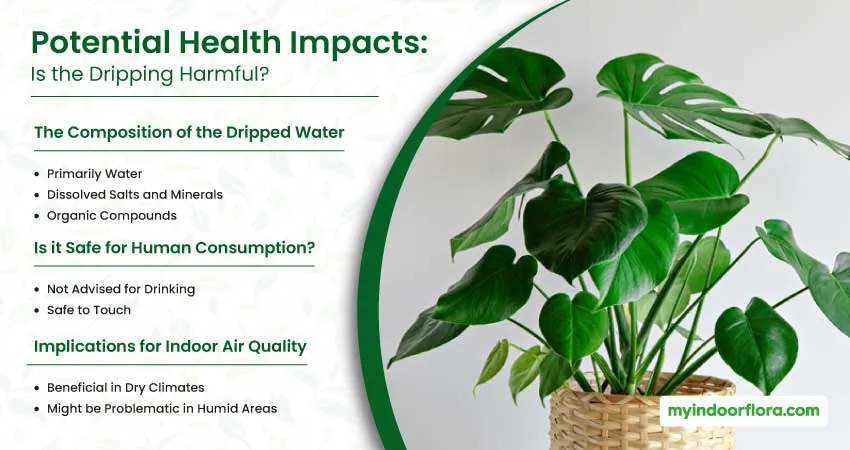
Monstera’s dripping phenomenon can pique curiosity about its implications for human health. Here’s a detailed exploration of the topic.
The Composition of the Dripped Water
Before jumping to conclusions, it’s essential to understand the composition of the water droplets.
- Primarily Water: The dripped liquid from Monstera guttation is mostly water.
- Dissolved Salts and Minerals: In trace amounts, these originate from the soil.
- Organic Compounds: Can be present, but in minuscule concentrations.
A study in the Journal of Plant Physiology analyzed the guttation droplets from various plants and found that while they contain some dissolved minerals and organic compounds, the concentrations are typically very low.
Is it Safe for Human Consumption?
In general, guttation water isn’t harmful to humans. However:
- Not Advised for Drinking: While not toxic, it’s best not to consume it due to potential contaminants from soil or other sources.
- Safe to Touch: Coming in contact with guttation droplets is typically harmless. However, if you have sensitive skin or specific allergies, it’s always wise to observe how your skin reacts.
Dr. Helena Morais, in a paper for the European Journal of Plant Science and Biotechnology, mentioned that while guttation water from most plants isn’t harmful, there’s little reason for humans to consume it, given its lack of nutritional value and potential for contaminants.
Implications for Indoor Air Quality
A thriving indoor Monstera can contribute to increased humidity levels due to transpiration and guttation.
- Beneficial in Dry Climates: Helps in maintaining moisture levels indoors.
- Might be Problematic in Humid Areas: Can contribute to mold growth or other humidity-related issues.
A 2015 research study from the Indoor Air Journal highlighted that indoor plants, including Monstera, can modify ambient humidity levels, which in turn can influence indoor air quality, for better or worse.
Preventing Excessive Water Dripping: Expert Tips
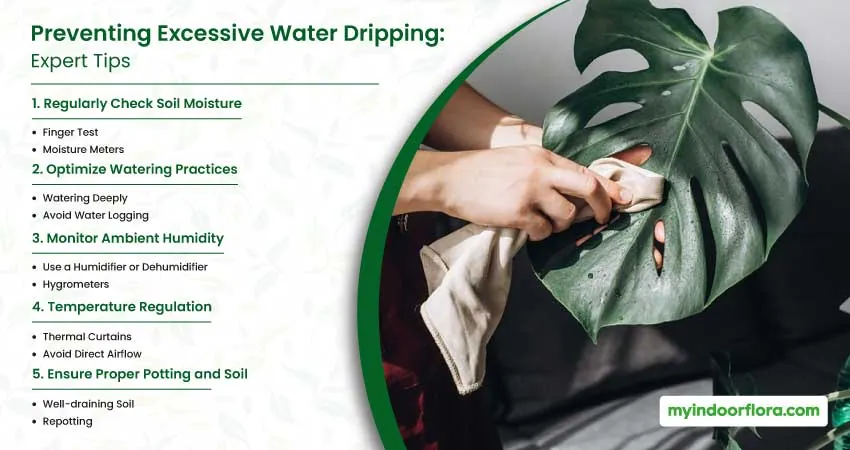
Monstera plants can indeed surprise their owners with water dripping from their leaves. While a natural phenomenon, excessive dripping can be an indication of imbalances in the plant’s environment. Thankfully, various expert-backed tips can help in managing and preventing excessive water dripping.
1. Regularly Check Soil Moisture
Before watering your Monstera, it’s essential to understand its moisture needs.
- Finger Test: Insert your finger into the soil up to 2 inches. If it feels dry, it’s time to water. If not, wait a few days.
- Moisture Meters: These are devices that, when inserted into the soil, give a moisture reading. They offer a more accurate measure than the finger test.
2. Optimize Watering Practices
The way you water your Monstera can make a significant difference.
- Watering Deeply: Ensure water reaches the deeper roots. It helps in even moisture distribution.
- Avoid Water Logging: Ensure that excess water can drain out. Pots with good drainage holes are a must.
Deep watering helps plants utilize water more efficiently, thus preventing unnecessary guttation.
3. Monitor Ambient Humidity
As guttation is closely linked to humidity, managing ambient conditions can make a difference.
- Use a Humidifier or Dehumidifier: Depending on whether you need to increase or decrease the ambient humidity.
- Hygrometers: Devices that measure indoor humidity. Helps in keeping track and making necessary adjustments.
4. Temperature Regulation
Avoid drastic temperature changes in the Monstera’s environment. Rapid temperature drops, especially during the night, can trigger guttation.
- Thermal Curtains: These can help maintain a consistent temperature, especially during colder months.
- Avoid Direct Airflow: From heaters or AC units. The direct blast can stress the plant.
5. Ensure Proper Potting and Soil
- Well-draining Soil: Loamy soil with good drainage properties can help prevent water logging.
- Repotting: If your Monstera is in a pot without adequate drainage, consider repotting.
Frequently Asked Questions (FAQs)
Does the size or age of my Monstera affect its tendency to drip water?
While guttation can occur in Monsteras of any age, mature plants with a more extensive root system might exhibit this behavior more often due to the increased capacity to absorb water.
Is guttation common in all houseplants or unique to Monstera?
While Monstera might be more noticeable in exhibiting guttation, it’s not unique to them. Other plants, especially those in the aroid family, like Philodendrons, can also show guttation under certain conditions.
If I notice my Monstera dripping excessively, should I move it to a different location?
While relocating can help, it’s essential to understand the cause. If it’s due to environmental factors, adjusting the plant’s environment might be more effective than just moving it. However, if it’s in a direct draft or intense sunlight, relocating might be beneficial.
Do Monsteras in their natural habitat exhibit guttation as well?
Yes, in their natural tropical rainforest habitat, Monsteras can exhibit guttation, especially during periods of heavy rainfall and high humidity.
How often should I expect to see water droplets on my Monstera leaves?
Occasional droplets, especially in the early morning, are natural. However, if you observe this frequently and in larger amounts, it might be a sign to re-evaluate your care routines.
Can I use fertilizers or additives to reduce guttation?
Fertilizers can influence guttation indirectly. Over-fertilization can increase solute concentration in the soil, potentially raising root pressure and the likelihood of guttation. It’s essential to follow recommended dosages and watering practices when using fertilizers.
Is guttation an indicator of my Monstera’s overall health?
Not necessarily. While guttation can hint at environmental conditions or care routines, occasional guttation is natural. However, persistent and excessive dripping should be a cue to reassess care practices.
Do different Monstera varieties have different tendencies to exhibit guttation?
While the fundamental process is the same, the frequency and amount of guttation might vary among different Monstera species due to variations in leaf structure, root systems, and overall size.
How does low light impact guttation in Monsteras?
Low light can reduce the rate of transpiration in plants, and if combined with excessive soil moisture, it might increase the chances of guttation.
Can I trim or alter my Monstera leaves to reduce guttation?
While you can trim damaged or unhealthy leaves, altering healthy leaves won’t necessarily reduce guttation and might even harm the plant. It’s better to address the root causes rather than altering the leaves.
Why is my Monstera dripping water even when I haven’t watered it recently?
Environmental factors like high humidity can amplify the guttation process in Monsteras. Even if you haven’t watered it recently, the ambient humidity combined with residual moisture in the soil can lead to guttation.
Will the dripping water from my Monstera harm my wooden furniture?
While the water itself is harmless, prolonged exposure can lead to water stains or damage on wooden surfaces. It’s advisable to keep a tray under the plant or ensure it’s placed in a location where the dripping won’t impact furniture.
Does repotting help in reducing excessive water dripping?
Yes, if your Monstera is in a pot without adequate drainage, repotting it into one with proper drainage holes can help. Moreover, using well-draining soil ensures that the roots aren’t waterlogged, reducing guttation.
